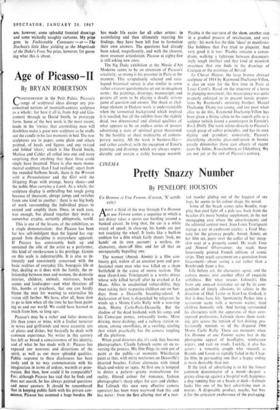CINEMA
Pretty Snazzy Number
By PENELOPE HOUSTON
ABOUT a third of the way through Un Homme et une Femme comes a sequence in which a test driver takes a sports car hurtling around a banked circuit. In long shot, the car is a white streak of speed; in close-up, his hands are just
not touching the wheel. It looks like a built-in emblem for a film which fairly shouts 'look, no hands' on its own account: a restless, ex- clamatory, show-off film; and for all that an unexpectedly beguiling one.
The woman (Anouk Aimee) is a film con- tinuity girl, widow of an amateur poet and pro- fessional stunt man who was killed on a sham battlefield in the cause of movie realism. The man (Jean-Louis Trintignant) is a works driver whose wife killed herself after he crashed at Le Mans. Allies in unadmitted vulnerability, they meet taking their respective children out on Sun- days from a Deauville boarding-school. A declaration of love is dispatched by telegram; he winds up a Monte Carlo Rally with a non-stop dash, Monte Carlo-Paris-Deauville. But the shadow of the dead husband, with his songs and his Camargue ponies, awkwardly looms. More driving, more dashing; and a railway station re- union, among snowflakes, in a swirling, circling shot which practically has the camera toppling off the platform.
When good directors die, it's said, they become photographers. Claude Lelouch seems set on re- versing the process. His film flings its own pot of paint at the public—at moments Whistlerian paint at that, with misty nocturnes on Deauville's deserted beaches. Colour alternates with tinted black-and-white or sepia. At first one is tempted to detect a pattern—grainy monochrome for reality, filtered colour for romance, fashion photographer's sharp edges for cars and clothes. But Lelouch (his own very effective camera operator) has been more wayward than this and less naive: from the first alluring shot of a rust- red trawler gliding out of the foggiest of sea fogs, he seems to let colour shape the mood.
Some of the beach scenes echo Boudin, trap- ping that cool light off a pale sea; back from the beaches it's more Sunday supplement, in the not unengaging area where the advertisements and the editorial content meet. Jean-Louis Trintignant zigzags a car in exuberant circles: a Ford Mus- tang for the getaway people. Anouk Aimee, on her film set, peers over the collar of her sheep-
skin coat at a property camel. He reads Time and Nouvel Observateur; she reads those luxuriously printed French editions of comic
strips. They reach agreement on a quotation from Giacometti—about saving a cat rather than a Rembrandt from a fire.
Life before art, the characters agree; and the camera moves into another effect of exquisite artfulness. But what rescues Lelouch's film from any amused resistance set up by its com- pendium of timely allusions, its salutes in the direction of Dick Lester or Jean-Luc Godard, is that it does have life. Spontaneity flashes into a restaurant scene with a nervous waiter; tired children humanly sulk. And having surrounded his characters with the apparatus of their over- exposed professions, Lelouch shows them work- ing, gets across the tension of fast driving, pro- fessionally reminds us of the disputed 1966 Monte Carlo Rally. There are moments when
Un Homme et une Femme seems lost in the
photogenic appeal of headlights, windscreen wipers, and rain on roads. Luckily, it also has actors: a romantic couple who succeed, as Brando and Loren so signally failed in the Chap- lin film, in persuading one that a happy ending is more desirable than not.
If the trick of advertising is to hit the lowest common 'denominator of a mood—despair a grainy close-up against a hospital wall, happiness a dog running free on a beach at dusk—Lelouch looks like one of the best advertising men in movies. A disposable product, maybe, but buy it for the articulate exuberance of the packaging.


































 Previous page
Previous page